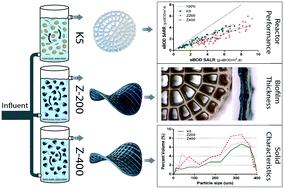当前位置:
X-MOL 学术
›
Environ. Sci.: Water Res. Technol.
›
论文详情
Our official English website, www.x-mol.net, welcomes your feedback! (Note: you will need to create a separate account there.)
The impact of biofilm thickness-restraint and carrier type on attached growth system performance, solids characteristics and settleability
Environmental Science: Water Research & Technology ( IF 5 ) Pub Date : 2020-08-07 , DOI: 10.1039/d0ew00314j Raheleh Arabgol 1, 2, 3, 4 , Peter A. Vanrolleghem 4, 5, 6, 7, 8 , Maria Piculell 9, 10, 11 , Robert Delatolla 1, 2, 3, 4
Environmental Science: Water Research & Technology ( IF 5 ) Pub Date : 2020-08-07 , DOI: 10.1039/d0ew00314j Raheleh Arabgol 1, 2, 3, 4 , Peter A. Vanrolleghem 4, 5, 6, 7, 8 , Maria Piculell 9, 10, 11 , Robert Delatolla 1, 2, 3, 4
Affiliation

|
The moving bed biofilm reactor (MBBR) technology is a proven standalone and add-on technology for carbon and nutrient removal from municipal wastewaters. The key challenge of the carbon removal MBBR technology is the production of poor settling biological solids and the need for intense solid separation methods. This study investigates the effect of carrier type and biofilm thickness-restraint on MBBR system performance, biofilm thickness, solids production, detachment rate, solids characteristics and settleability. Two new emerging “thickness-restraint” carriers, AnoxK™ Z-200 and Z-400 (allowing for 200 and 400 μm maximum biofilm thickness, respectively), are compared to the conventional AnoxK™ K5 carrier at BOD loading rates of 6 g-sBOD m−2 d−1. The obtained results indicate that carrier type has a significant effect on MBBR carbonaceous removal, biofilm thickness, detachment and solids production. The K5 carrier MBBR system demonstrated statistically significant higher carbonaceous removal rates of 3.8 ± 0.3 g-sBOD m−2 d−1, higher biofilm thickness (281.1 ± 8.7 μm), lower solids production (7.7 ± 3.2 mg-TSS L−1) and greater stability with respect to the detachment rate compared to the two Z-carriers. Particle size distribution analysis demonstrates a higher percentage of small particles in Z-carrier system effluent and hence significantly lower solids settling efficiency. Therefore, the K5 carrier produced solids with improved settling characteristics compared to Z-carriers. No significant difference was observed in removal efficiency, solids production, detachment rate, particle characteristics and settling behaviour when comparing the Z-200 to the Z-400, indicating that biofilm thickness-restraint carrier design was not a controlling factor in the settling potential of produced solids.
中文翻译:

生物膜厚度限制和载体类型对附着的生长系统性能,固体特性和沉降性的影响
移动床生物膜反应器(MBBR)技术是一种经过验证的独立的附加技术,可从市政废水中去除碳和营养。除碳MBBR技术的关键挑战是沉降性差的生物固体的生产以及对严格的固体分离方法的需求。本研究研究了载体类型和生物膜厚度限制对MBBR系统性能,生物膜厚度,固体产量,分离速率,固体特性和沉降性的影响。将两种新出现的“厚度限制”载体AnoxK™Z-200和Z-400(分别允许最大200和400μm的最大生物膜厚度)与传统的AnoxK™K5载体在6 g- sBOD m -2 d -1。获得的结果表明,载体类型对MBBR碳质去除,生物膜厚度,分离和固体产生有重大影响。K5载体MBBR系统在统计学上显示出较高的碳去除率(3.8±0.3 g-sBOD m -2 d -1),较高的生物膜厚度(281.1±8.7μm),较低的固体生成量(7.7±3.2 mg-TSS L -1)),并且与两个Z载体相比,分离率更高。粒度分布分析表明,Z载体系统流出物中的小颗粒百分比更高,因此固体沉降效率大大降低。因此,与Z载体相比,K5载体产生的固体具有改善的沉降特性。将Z-200与Z-400进行比较时,去除效率,固体生成,分离速率,颗粒特性和沉降行为均未观察到显着差异,这表明生物膜厚度限制载体的设计不是其沉降潜力的控制因素。产生的固体。
更新日期:2020-10-02
中文翻译:

生物膜厚度限制和载体类型对附着的生长系统性能,固体特性和沉降性的影响
移动床生物膜反应器(MBBR)技术是一种经过验证的独立的附加技术,可从市政废水中去除碳和营养。除碳MBBR技术的关键挑战是沉降性差的生物固体的生产以及对严格的固体分离方法的需求。本研究研究了载体类型和生物膜厚度限制对MBBR系统性能,生物膜厚度,固体产量,分离速率,固体特性和沉降性的影响。将两种新出现的“厚度限制”载体AnoxK™Z-200和Z-400(分别允许最大200和400μm的最大生物膜厚度)与传统的AnoxK™K5载体在6 g- sBOD m -2 d -1。获得的结果表明,载体类型对MBBR碳质去除,生物膜厚度,分离和固体产生有重大影响。K5载体MBBR系统在统计学上显示出较高的碳去除率(3.8±0.3 g-sBOD m -2 d -1),较高的生物膜厚度(281.1±8.7μm),较低的固体生成量(7.7±3.2 mg-TSS L -1)),并且与两个Z载体相比,分离率更高。粒度分布分析表明,Z载体系统流出物中的小颗粒百分比更高,因此固体沉降效率大大降低。因此,与Z载体相比,K5载体产生的固体具有改善的沉降特性。将Z-200与Z-400进行比较时,去除效率,固体生成,分离速率,颗粒特性和沉降行为均未观察到显着差异,这表明生物膜厚度限制载体的设计不是其沉降潜力的控制因素。产生的固体。


























 京公网安备 11010802027423号
京公网安备 11010802027423号